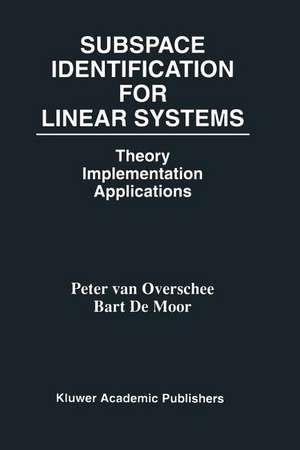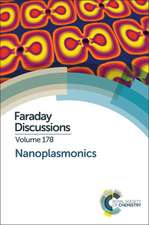Subspace Identification for Linear Systems: Theory — Implementation — Applications
Autor Peter van Overschee, B.L. de Mooren Limba Engleză Paperback – 8 oct 2011
The theory of subspace identification algorithms is presented in detail. Several chapters are devoted to deterministic, stochastic and combined deterministic-stochastic subspace identification algorithms. For each case, the geometric properties are stated in a main 'subspace' Theorem. Relations to existing algorithms and literature are explored, as are the interconnections between different subspace algorithms. The subspace identification theory is linked to the theory of frequency weighted model reduction, which leads to new interpretations and insights.
The implementation of subspace identification algorithms is discussed in terms of the robust and computationally efficient RQ and singular value decompositions, which are well-established algorithms from numerical linear algebra. The algorithms are implemented in combination with a whole set of classical identification algorithms, processing and validation tools in Xmath's ISID, a commercially available graphical user interface toolbox. The basic subspace algorithms in the book are also implemented in a set of Matlab files accompanying the book.
An application of ISID to an industrial glass tube manufacturing process is presented in detail, illustrating the power and user-friendliness of the subspace identification algorithms and of their implementation in ISID. The identified model allows for an optimal control of the process, leading to a significant enhancement of the production quality. The applicability of subspace identification algorithms in industry is further illustrated with theapplication of the Matlab files to ten practical problems. Since all necessary data and Matlab files are included, the reader can easily step through these applications, and thus get more insight in the algorithms.
Subspace Identification for Linear Systems is an important reference for all researchers in system theory, control theory, signal processing, automization, mechatronics, chemical, electrical, mechanical and aeronautical engineering.
Preț: 780.06 lei
Preț vechi: 951.29 lei
-18% Nou
Puncte Express: 1170
Preț estimativ în valută:
149.27€ • 159.62$ • 124.45£
149.27€ • 159.62$ • 124.45£
Carte tipărită la comandă
Livrare economică 18 aprilie-02 mai
Preluare comenzi: 021 569.72.76
Specificații
ISBN-13: 9781461380610
ISBN-10: 1461380618
Pagini: 272
Ilustrații: 272 p.
Dimensiuni: 155 x 235 x 14 mm
Greutate: 0.39 kg
Ediția:Softcover reprint of the original 1st ed. 1996
Editura: Springer Us
Colecția Springer
Locul publicării:New York, NY, United States
ISBN-10: 1461380618
Pagini: 272
Ilustrații: 272 p.
Dimensiuni: 155 x 235 x 14 mm
Greutate: 0.39 kg
Ediția:Softcover reprint of the original 1st ed. 1996
Editura: Springer Us
Colecția Springer
Locul publicării:New York, NY, United States
Public țintă
ResearchCuprins
1 Introduction, Motivation and Geometric Tools.- 1.1 Models of systems and system identification.- 1.2 A new generation of system identification algorithms.- 1.3 Overview.- 1.4 Geometric tools.- 1.5 Conclusions.- 2 Deterministic Identification.- 2.1 Deterministic systems.- 2.2 Geometric properties of deterministic systems.- 2.3 Relation to other algorithms.- 2.4 Computing the system matrices.- 2.5 Conclusions.- 3 Stochastic Identification.- 3.1 Stochastic systems.- 3.2 Geometric properties of stochastic systems.- 3.3 Relation to other algorithms.- 3.4 Computing the system matrices.- 3.5 Conclusions.- 4 Combined Deterministic-Stochastic Identification.- 4.1 Combined systems.- 4.2 Geometric properties of combined systems.- 4.3 Relation to other algorithms.- 4.4 Computing the system matrices.- 4.5 Connections to the previous Chapters.- 4.6 Conclusions.- 5 State Space Bases and Model Reduction.- 5.1 Introduction.- 5.2 Notation.- 5.3 Frequency weighted balancing.- 5.4 Subspace identification and frequency weighted balancing.- 5.5 Consequences for reduced order identification.- 5.6 Example.- 5.7 Conclusions.- 6 Implementation and Applications.- 6.1 Numerical Implementation.- 6.2 Interactive System Identification.- 6.3 An Application of ISID.- 6.4 Practical examples in Matlab.- 6.5 Conclusions.- 7 Conclusions and Open Problems.- 7.1 Conclusions.- 7.2 Open problems.- A Proofs.- A.1 Proof of formula (2.16).- A.2 Proof of Theorem 6.- A.3 Note on the special form of the Kalman filter.- A.4 Proof of Theorem 8.- A.5 Proof of Theorem 9.- A.6 Proof of Theorem 11.- A.7 Proof of Theorem 12.- A.8 Proof of Lemma 2.- A.9 Proof of Theorem 13.- A.10 Proof of Corollary 2 and 3.- A.11 Proof of Theorem 14.- B Matlab Functions.- B.1 Getting started.- B.2 Matlab Reference.- B.2.1 Directory: ‘subfun’.- B.2.2 Directory: ‘applic’.- B.2.3 Directory: ‘examples’.- B.2.4 Directory: ‘figures’.- C Notation.- References.
Recenzii
`The book is definitely a must for academics and engineers who are interested in modern system identification techniques. Since the main algorithms are supplied on a disk accompanying the book, it is very easy to get started using the proposed algorithms.'
T. McKelvey, International Journal of Adaptive Control and Signal Processing, 12:6, (1998)
T. McKelvey, International Journal of Adaptive Control and Signal Processing, 12:6, (1998)
























